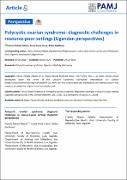Polycystic ovarian syndrome: diagnostic challenges in resource-poor settings (Ugandan perspectives)
| dc.contributor.author | Pebolo, Pebalo Francis | |
| dc.contributor.author | Auma, Anna Grace | |
| dc.contributor.author | Alobo, Gasthony | |
| dc.date.accessioned | 2021-04-02T20:34:40Z | |
| dc.date.available | 2021-04-02T20:34:40Z | |
| dc.date.issued | 2021 | |
| dc.identifier.citation | Francis Pebalo Pebolo et al. Polycystic ovarian syndrome: diagnostic challenges in resource-poor settings (Ugandan perspectives). PAMJ Clinical Medicine. 2021;5(41). 10.11604/pamj-cm.2021.5.41.26386 | en_US |
| dc.identifier.uri | https://www.clinical-medicine.panafrican-med-journal.com//content/article/5/41/full | |
| dc.identifier.uri | https://hdl.handle.net/123456789/229 | |
| dc.description.abstract | Polycystic ovarian syndrome is the most common cause of anovulatory infertility accounting for up to 40% of the reasons for visiting a doctor. The Ugandan government has recognized infertility as a major problem affecting over five million people, yet polycystic ovarian syndrome is not included in the Ugandan Clinical Guidelines, hence it´s not part of the Uganda minimum healthcare package. Lack of guidelines means diagnosis is a challenge and many cases have delayed or no diagnosis. Early diagnosis is good for awareness of associated risks such as infertility, dysfunctional uterine bleeding, endometrial cancer, obesity, diabetes, dyslipidemia, hypertension, and cardiovascular diseases. Clinical laboratories are handy in the diagnosis as well as follow-up of PCOS cases and in most rural settings, these are lacking, confounded by the lack of skilled frontline workers such as gynecologists and reproductive endocrinologists. | en_US |
| dc.language.iso | en | en_US |
| dc.publisher | PAMJ Clinical Medicine | en_US |
| dc.subject | Polycystic ovarian syndrome | en_US |
| dc.subject | Uganda | en_US |
| dc.subject | infertility | en_US |
| dc.subject | laboratory | en_US |
| dc.title | Polycystic ovarian syndrome: diagnostic challenges in resource-poor settings (Ugandan perspectives) | en_US |
| dc.type | Article | en_US |
Files in this item
This item appears in the following Collection(s)
-
Research Articles [13]

